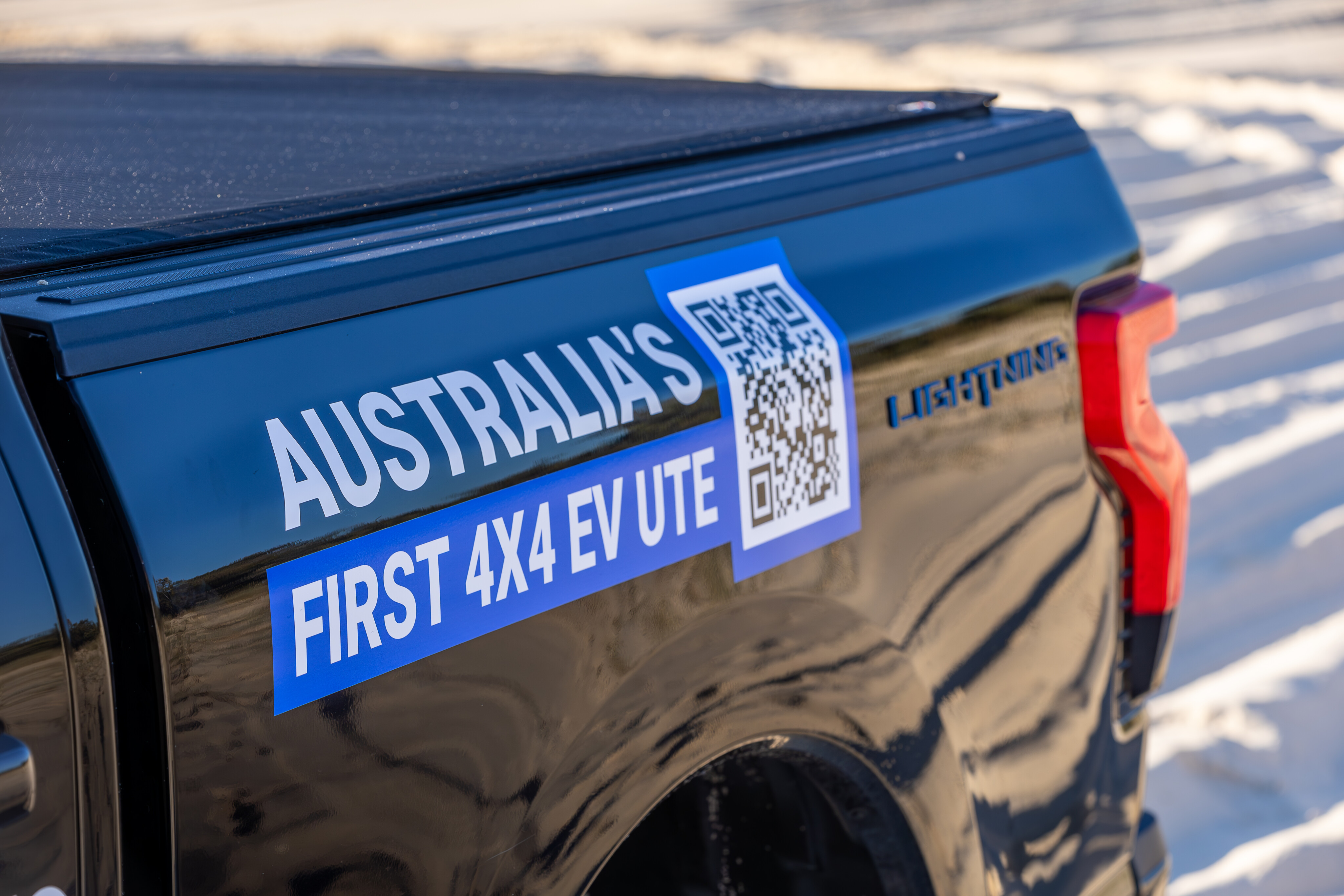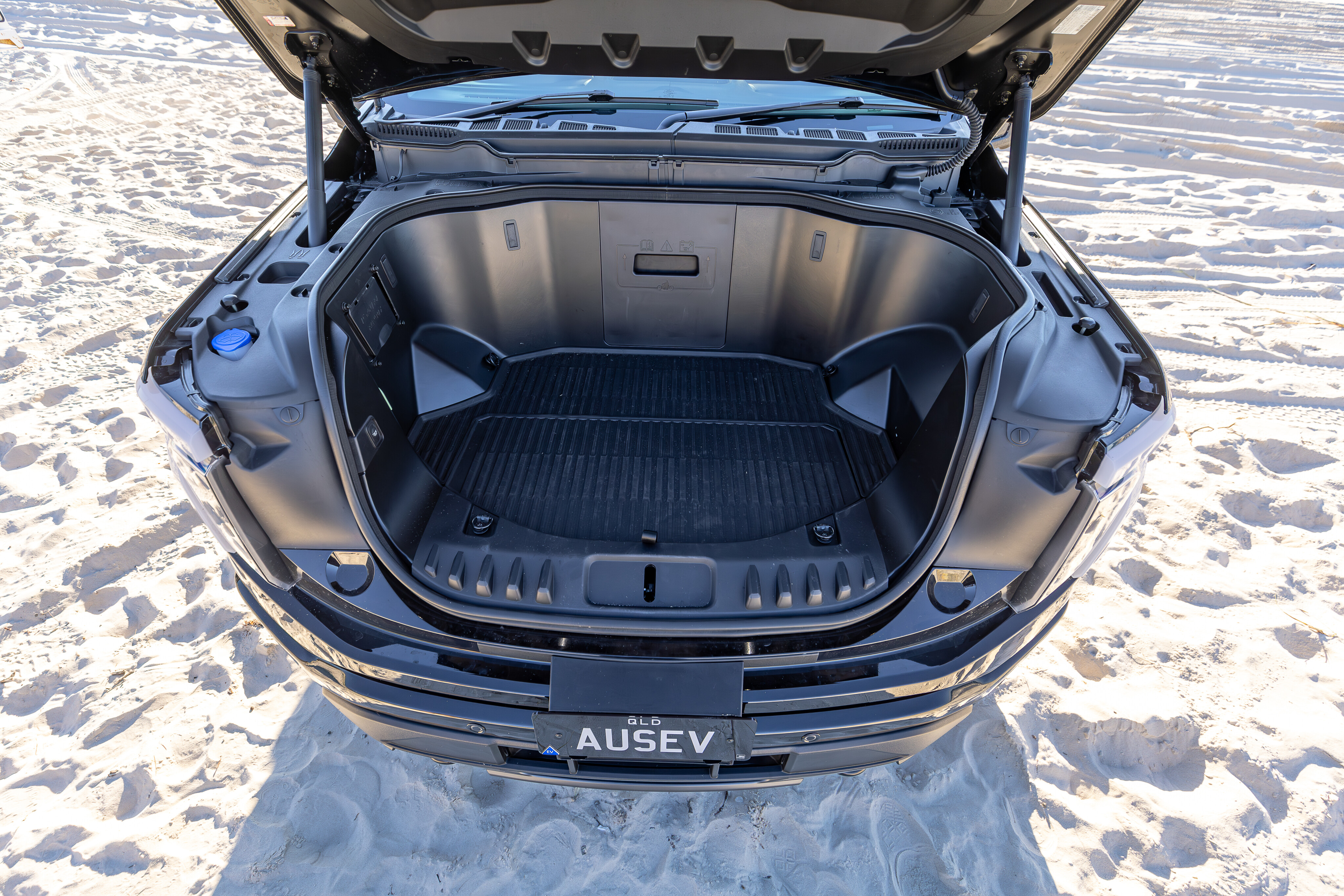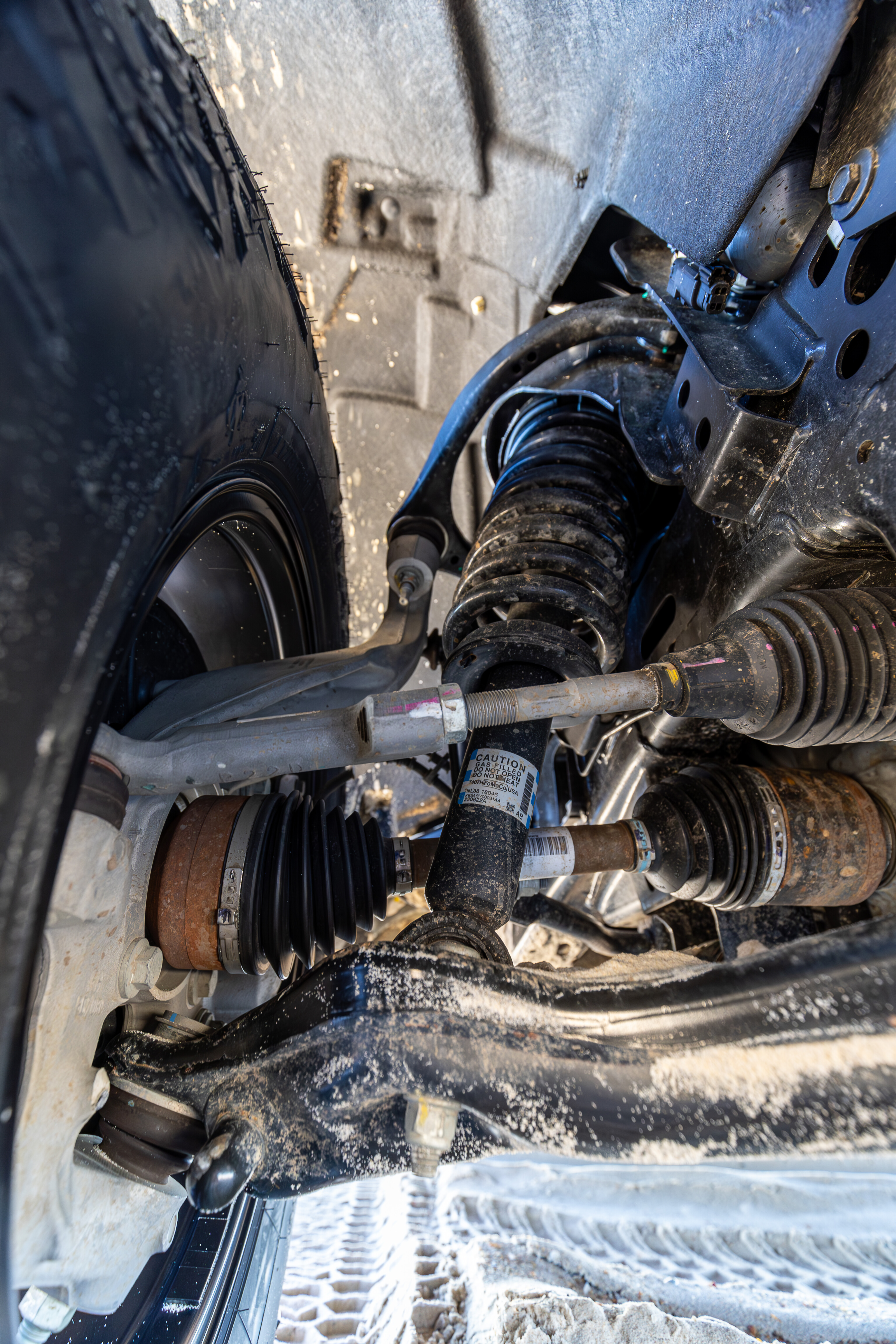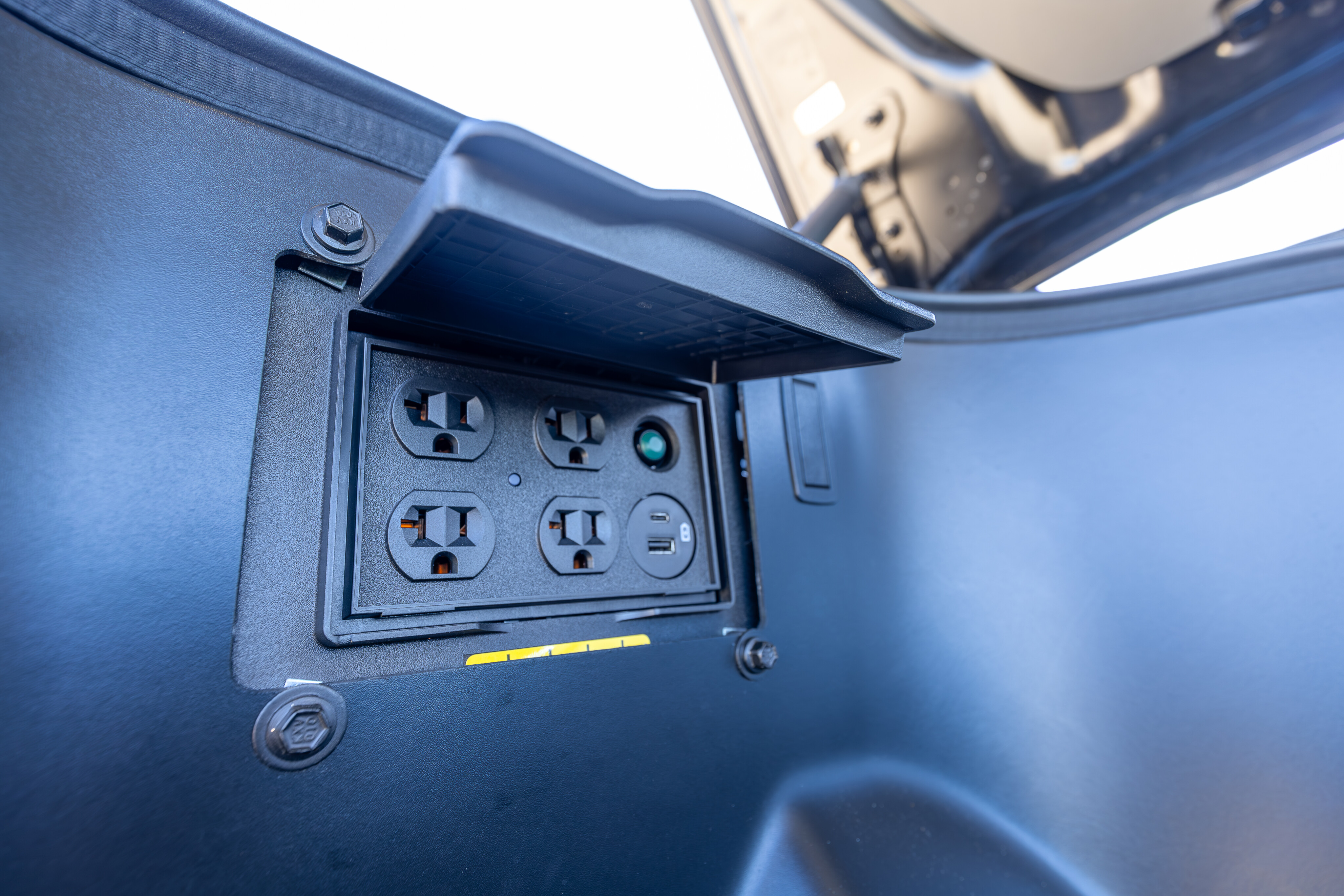
Pick-up trucks are a hit Down Under, and while the late-to-class Ford F-150 is very good, despite offering V6 rather than V8 grunt, you might be in luck if instant torque and silent power is more your thing.
We recently caught wind that there was a warehouse full of all-electric F-150 Lightnings in Brisbane – converted to right-hand drive, no less – so we went knocking. It turns out AUSEV – who brings the Lightnings in, converts and then sells them – said yes to our proposition, which went something along the lines of: “Please let us take one of them off-road… we’ll be gentle.”
The F-150 Lightning Extended Range we picked up was remanufactured to RHD by Advanced Manufacturing Queensland (AMQ). Like AUSEV, who sells them, AMQ is a subsidiary of the broader BOSSCAP Group of companies.
These guys have been converting cars to right-hand drive for around a decade, with a particular focus on yank tanks through sister company AUSMV. However, as of this year, the company has turned its focus to electric vehicles, the first of which is the F-150 Lightning.
We picked up the Lightning with around 90 per cent charge, or 400km of range, from AUSEV’s conversion facility at Brendale in Brisbane’s northern suburbs. The plan was to shoot north, 60km or so to the 4x4 beach at Bribie Island. Using 120km of charge for the journey there and back, we’d have 380km to play with on the sand. Beauty.
JUMP AHEAD
- What do you get?
- Powertrain
- On-road performance
- Off-road performance
- Range and charging
- Pricing and warranty
- Verdict
- Specifications
What do you get?
We pored over the conversion and, aside from the injection-moulded dash and RHD steering modifications, it’s essentially the same as the US Lightning model.
We wouldn’t have known this was converted if someone didn’t tell us, and we were actively trying to spot imperfections. The guys also fitted this demo model with 18-inch Method Wheels (which look small on an Effie) and 275/70 R18 Maxxis RAZR all-terrains, plus a ReadyLIFT 2-inch lift kit. They told us they actually had 35s on it but they scrubbed, so the decision to move down to 33s was made.

A week prior to this drive, we’d used a couple of LWB F-150 XLTs to drive 2500km in convoy from Melbourne to Alice Springs for the Finke Desert Race, so the layout felt familiar. The Lightning is every bit an F-truck inside, with lounge-like comfort and fold-out-this and fold-out-that, not to mention all the switches. It’s still fairly utilitarian for an EV, though, clearly aimed at work or adventure rather than straight-out luxury.
In fact, aside from the huge digital dash and 12-inch infotainment screen, which display all matter of battery and driving range data, you wouldn’t necessarily know you’re in an electric Effie. We like that they haven’t tried to reinvent the wheel here, or change a good thing.
Powertrain
At its core, the Lightning is made up of either a base 98kWh or extended-range 131kWh battery (we tested the big one), with an ‘e-axle’ at each end for constant four-wheel-drive.
The liquid-cooled battery is completely sealed, keeping water and dust out, and electric motors are housed where the diffs would normally sit, with half shafts sending drive to each hub. It’s all covered by underbody protection, but we wouldn’t want to test how well it bounces off a rock. Serious underbody protection would be one of our first purchases, given how much of the vehicle’s value lies beneath it.

The total output across both motors is 433kW/1050Nm, which feels as insane as it sounds. Despite the gargantuan torque underfoot, it has a rated range of 515km on a single charge which is, based on our testing, pretty accurate.
All that power means the Lightning will shoot to 100km/h in around four seconds, which puts it neck-and-neck with the F-150 Raptor R and Ram 1500 TRX, but it feels quicker than the stopwatch suggests.
It accelerates more dramatically than other EVs, likely because the Maxxis RAZR tyres weren’t designed to wrangle 1050Nm – from zero rpm – as they squeal and squirm under load. The best way to describe the acceleration is that it shocks the senses during the initial ‘hit’ of torque, but doesn’t continue to build like a big-power engine. It’s more of a blunt-force impact than the three-punch combo we are used to – the noise, smell and buildup of combustion power.
It’s extremely addictive to punch up to speed, before settling right back into regular, whisper-quiet driving… aside from the tyre noise, which seems 10 times louder than usual in an EV.
On-road performance
The Lightning steers and stops much the same as a petrol F-150, which is a good thing, but regenerative braking gives it the edge when pulling up.
You don’t choose the level of regen you want, you just choose from Normal, Sport, Tow or Off-road modes and hit it. There is the option of ‘one-pedal’ driving, but it throws the anchors on hard with every lift off the accelerator pedal. We preferred using both pedals, especially off-road where momentum isn’t something we want to give away for free.
On a side note, the pedals are adjustable, which is an Effie feature that should be standard in more vehicles. A little switch to the right of your accelerator leg adjusts both pedals up or down, letting you fine-tune the position.

This Lightning has all the same passive and active safety technology we have come to expect in high-end Ford models, with the usual pre-collision warning, autonomous emergency braking, rear cross-traffic alert and a 360-degree camera system. During our on-road driving, though, we didn’t notice any of the technology interfering with or annoying us.
These Lightnings will tow a full 4500kg, but payload is limited to 885kg, which has a for the 1.6m tub. It’s a heavy ute, tipping the scales at nearly three tonnes, which eats into GVM.
Effie’s and other 1500 class utes – denoting their payload in pounds – are best suited to those who plan to tow, which a lot dual-cab owners do. Seriously heavy canopies are possible, with a GVM upgrade, but a camper trailer is ideal behind one of these. We recently towed two 4-tonne-plus trailers behind petrol F-150 LWB XLT models – for that Finke trip mentioned earlier – and for pulling weight, American pick-ups are unmatched by anything else you can drive on a car licence.
Off-road performance
This Lightning model has ground clearance of 213mm, approach angle of 24.4 degrees, rampover angle of 17.6 degrees, and departure angle of 23.6 degrees.
The 2.0-inch lift and bigger rubber on our test vehicle improves on these numbers, but is still not a match for something like a LandCruiser or Patrol. Then there is the inherent heft of a battery-powered 4x4, tipping the scales at 2885kg, which isn’t normally ideal in sand or mud. But what 1500-class utes lack in genetic potential, they make up for in attitude, and with this much (instant) power all of the numbers were quickly forgotten.
We aired down to 30psi at the beach entry, purely because we wanted to see if it would do it with plenty of air left in the tyres. It did, and it probably would have been fine with the full 40psi. Flicking into off-road mode locks the rear diff, turns traction control off and it’s ready to go. It’s that simple. The beach entry was eventful, because the lightning throws ‘accidental’ roost if you even breathe on the accelerator.

The Bribie access track is a good gauge for suspension, too, because it’s rough year-round. We could feel the weight of the Effie but coils at the rear help and a lot of its weight is down between the rails, so it feels lighter than it is.
Laying under the vehicle after getting onto the beach, it doesn’t look all that different but did confuse us at first. “Where’s the exhaust?” our photographer asked before quickly remembering it doesn’t have one. The layout is logical, with front and rear diffs (housing motors), shafts, hubs and all the arms you’d expect on a 4x4 ute. The battery is tucked up between the rails, so you can’t even see it from underneath.
While the chassis and general layout is similar to that of a petrol F-150 – bar the missing engine over the front-end – the biggest change is independent suspension all around.
Gone is the live axle and leaf springs at the back, with an independent coil-spring setup in its place. The rear control arms are enormous and even the rear shock mounts look unusually beefy… presumably to handle all that twist. Speaking of twist, performance on the sand is unreal. We don’t really know how else to put it. In a diesel or petrol vehicle, power builds as engine (and wheel) speed increases, so you’re moving by the time peak torque is there. In the Lightning, the full 1000Nm wack-in-the-back is ‘on’ from zero rpm.

Suddenly, with no delay whatsoever, it spins up all four wheels and actually requires careful throttle control to avoid digging a hole. It needs to be babied a bit on soft sand, at least until you’re up and moving, but then it’s a riot.
We don’t condone foolishness, but it’s hard not to slam the pedal to the floor in the Lightning. It accelerates like a three-tonne UTV, which is the closest thing we can liken it to. This leads us to the consequence of driving it hard, which is diminished range. Before you nod, agreeing that EVs are doomed because of their range limitations, let’s just acknowledge that lead-footed driving does the same thing in a combustion car.
What the F-150 does is offer an accurate kWh/100km reading, which shoots up during off-road work but remains true to the claims made by Ford. Some earlier EVs we drove, and trucks too, gave blatantly unrealistic range indications and plummeted once they got down to 20 or 30 per cent charge.
This system is pretty simple: monitor the kWh/100km readout and range indicator, while factoring in the 131kWh total capacity. It’s like watching your fuel gauge, knowing you’re into the 20s off-road but will drop back to 10L/100km on the highway, and managing consumption that way.
Range and charging
For the performance on tap, the 500-or-so kilometre range – even if it drops to 350 when being driven hard – seems pretty reasonable.
The average energy use was showing 22kWh/100km when we picked it up, but after beach work it was up to 34kWH/100km. Based on the 131kWh battery, that means a range of 385km including off-road driving. With the standard 98kWh unit, you’d be struggling to get 300 clicks with a consumption average like ours.
We would have liked to see what towing does to the range for this Lightning model, but that’ll be one for another time. If it doubles or even triples fuel use in a combustion vehicle, we can assume it’ll do similar in an EV. The reality is, most beaches and tracks are pretty close to a servo and most have a charger these days. We found one around 10-minutes drive from the beach access track, but had enough range to get back to Brisbane if we wanted to.

A BP Pulse charger pumped around 50kW of constant energy into the Lightning, nowhere near the 150kW it can receive, but pretty standard in Australia. The AUSEV guys told us they’ve had it right up at the 150kW mark using their own charger, which will get the battery from 15 to 80 per cent in just under 40 minutes.
The BP Pulse charge cost us around $40, after one false start that only put $15 of juice in before the charger decided to go to sleep – a BP issue, not a Lightning issue. As the chargers get better, the hour I spent having lunch could be down to 30 minutes.
While charging, because it doesn’t take an hour to eat a sandwich, we had a proper look around the Lightning. It has four 120V power outlets at the rear and another four inside the ‘frunk’, the 400-litre front trunk compartment where the engine would otherwise be, but these have been disabled (blanked-out) for compliance reasons. AUSEV told us they have engineered an aftermarket solution, though.

Essentially, this means you could run a fridge off outlet power, the frunk being a particularly handy weather-sealed spot for one. The entire vehicle can also put out up to 9.6kW, using the vehicle’s bi-directional charging function, giving you a powered campsite on wheels.
It also has a zone lighting feature, similar to that found in new Ranger and Everest models, which lets you illuminate sections of the vehicle depending on where you need light. Not much good during the day, but a lifesaver if you get to a campsite at night.
Pricing and warranty
Now, US pricing isn’t much use here, so let’s talk about how much you’ll have to fork out for one of these in Australia.
AUSEV offers the extended range Lightning for $209,900 plus on-road costs, and the standard range Commercial spec for $179,000. Our Luxury spec tester had an extra $10,000 thrown at it for the purpose of bettering its off-road ability.
AUSEV also offers a five-year, unlimited kilometre warranty for all Lightning models, which includes five years of complementary servicing. As is the case with other EVs, servicing requirements are seriously reduced and all it needs in the first year is a cabin air filter.
Verdict
The point of the Lightning is probably not to have as much fun as possible off-road like we set out to do, and early electric adopters don’t seem that way inclined. But the fact it can be done is a win in our books. Driven sensibly during the week, packed up for weekend getaways, and occasionally used to embarrass just about anything at a set of lights, it’ll do it all.
It’s not the best EV, nor the best 4x4, but it’s the only 4x4 EV and it’s better than we hoped.
Specifications
| 2024 Ford F-150 Lightning | |
|---|---|
| Price | $209,900 +ORC |
| Engine | Dual eMotor 4WD |
| Max power | 433kW |
| Max torque | 1050Nm |
| 4x4 system | Full-time 4x4 with locking rear diff |
| Construction | 4-door ute body on separate chassis |
| Suspension | Fully independent with coil springs |
| Tyres | 275/70 R18 Maxxis RAZR all-terrain |
| Weight | 2885kg (tare) |
| GVM | 3878kg |
| GCM | 7756kg |
| Towing capacity | 4500kg |
| Payload | 885kg |
| Seats | 5 |
| Battery | 131kWh |
| Charge time (15-80%) | 150kW DCFC 38 minutes |
| Consumption (tested) | 22kWh/100km (road) / 34kWh/100km (sand) |
| Approach angle | 24.4° |
| Ramp over angle | 17.6° |
| Departure angle | 23.6° |
| Ground clearance | 213mm |
| Wading depth | 610mm |



COMMENTS